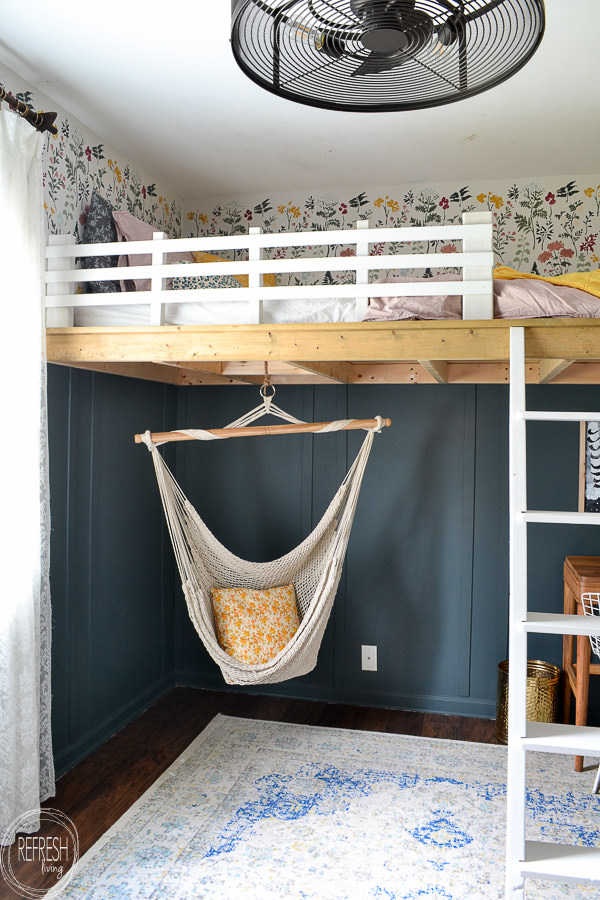- 8 Airplane Footrest Hammock!Travel comfortably - October 9, 2023
- top 7 Pool Float Water Hammock for a Relaxing Summer - October 9, 2023
- top 5 Space SaverSingle Hammock Stand Maximize Comfort and Space - October 9, 2023
To hang a hammock under a loft bed, attach it to the ladder rungs or beams using the straps that come with the hammock or heavy-duty straps purchased separately. Avoid hanging the hammock from metal studs as they may not support the weight.
Instead, secure it between wood studs, solid wood posts, or ceiling joists. Another option is to hang a hammock chair under the loft bed or in the door frame using simple solutions like hooks or straps. Ensure that the hammock is securely tightened and properly supported for safe use.
Choosing The Right Hammock
When it comes to hanging a hammock under a loft bed, choosing the right hammock is crucial for comfort and safety. There are several factors to consider when selecting a hammock for a loft bed. In this section, we will discuss these factors and explore the different types of hammocks that are suitable for hanging under a loft bed.
Factors to Consider When Selecting a Hammock for a Loft Bed
Before purchasing a hammock for your loft bed, there are a few important factors to keep in mind. These factors will help you choose a hammock that is the perfect fit for your needs:
- Size: Consider the size of your loft bed and the available space underneath it. Measure the length and width to ensure the hammock will fit properly.
- Weight Capacity: Check the weight capacity of the hammock to ensure it can support your weight and any additional weight you may add while using it.
- Material: Choose a hammock made from durable materials such as nylon or polyester. These materials are lightweight, easy to clean, and resistant to weather conditions.
- Attachment Options: Look for hammocks that come with straps or ropes for easy attachment to the loft bed. Adjustable straps will allow you to customize the height and tension of the hammock.
Different Types of Hammocks Suitable for Hanging Under a Loft Bed
There are several types of hammocks available that are suitable for hanging under a loft bed. Each type offers a unique design and features:
| Type | Description |
|---|---|
| Double Hammock | A double hammock is designed for two people. It offers a wider sleeping surface and can accommodate more weight. This type of hammock is perfect for those who enjoy sharing their hammock space with a partner. |
| Portable Hammock | A portable hammock is lightweight and easy to transport. It is ideal for those who want to take their hammock on outdoor adventures or move it around the house as needed. |
| Hammock Chair | A hammock chair is a great option if you prefer a more upright sitting position. It offers the comfort of a hammock with the support of a chair. |
| Camping Hammock | A camping hammock is designed for outdoor use. It is made from durable materials that are resistant to weather conditions. This type of hammock is perfect for those who want to enjoy the outdoors while relaxing under their loft bed. |
By considering these factors and exploring different types of hammocks suitable for hanging under a loft bed, you can choose the right hammock that will provide comfort and relaxation in your space. Hang your hammock properly following the manufacturer’s instructions to ensure safety and a pleasant experience.
Assessing The Bed Structure
Determining if the loft bed is structurally capable of supporting a hammock
Hanging a hammock under a loft bed can be a great way to maximize space in a smaller room or create a cozy reading nook. However, before you jump into setting up your hammock, it’s important to assess the bed structure to ensure it can support the weight and movement. Here are a few steps to help you determine if your loft bed is structurally capable of supporting a hammock:
- Check the weight capacity: Start by checking the manufacturer’s instructions or documentation that came with your loft bed. Look for any weight restrictions or guidelines to ensure that your hammock will not exceed the bed’s weight capacity. If you cannot find this information, consider reaching out to the manufacturer or contacting a professional to assess the bed’s capabilities.
- Examine the construction: Take a close look at the construction of the loft bed. Look for any signs of wear or damage, such as cracks, loose joints, or weakened supports. These issues can compromise the bed’s structural integrity and may not be suitable for hanging a hammock. If you notice any of these problems, it’s best to address them before proceeding with the installation.
- Consider additional support: If you’re unsure about the bed’s ability to support the hammock, you may want to consider adding additional support. This can involve reinforcing the bed frame with brackets or support beams, or even installing wall-mounted hooks or anchors for added stability. Consulting with a professional or an experienced handyman can help ensure that you’re taking the necessary precautions to create a safe and secure hammock setup.
Checking for secure attachment points on the bed frame or walls
Once you’ve determined that your loft bed is structurally capable of supporting a hammock, the next step is to identify secure attachment points. These are critical for ensuring that your hammock hangs safely and securely. Here are some key considerations when checking for attachment points:
- Bed frame: Examine the bed frame for any designated attachment points, such as hooks or loops, that may have been included by the manufacturer. If your loft bed does not have these attachments, you can explore other options such as attaching straps or carabiners to secure points on the bed frame.
- Walls: Look for sturdy wall studs or beams that can support the weight of the hammock. Use a stud finder or tap on the wall to identify solid areas for attachment. Avoid attaching the hammock to drywall or unsupported areas, as they may not provide enough strength or stability.
In addition to these attachment points, it’s essential to ensure that the hammock is properly hung at an appropriate height and tension. Follow the manufacturer’s instructions for setting up your hammock, and regularly inspect the attachments and hammock for any signs of wear or damage. By taking these precautions, you can enjoy a safe and comfortable hammock experience under your loft bed.
Installing Hammock Straps Or Hooks
When it comes to setting up a hammock under a loft bed, you have two options for securely hanging it – using hammock straps or hooks. Both methods are effective and can provide a comfortable and relaxing space for you to unwind.
Steps for attaching hammock straps to the loft bed frame or walls
- Start by finding strong anchor points on the loft bed frame or walls where you can attach the hammock straps. These anchor points should be able to support your weight and the tension of the hammock.
- Once you have identified the anchor points, wrap the hammock straps around these points and secure them tightly. Make sure the straps are evenly distributed and there is no sagging or uneven tension.
- Use the adjustable buckles on the straps to fine-tune the height and tension of the hammock. This will allow you to customize the height and comfort level according to your preference.
- Finally, test the stability of the hammock by gently sitting or lying in it. Make sure it can hold your weight without any signs of strain or sagging. Adjust the straps if necessary.
Using hooks for hanging the hammock securely
- Choose strong and sturdy hooks that are capable of supporting your weight and the weight of the hammock.
- Identify the ideal placement for the hooks – either on the loft bed frame or on the walls. Make sure the hooks are evenly spaced and aligned with the desired position of the hammock.
- Drill pilot holes at the chosen locations to ensure a secure and stable attachment of the hooks. Use a drill bit that matches the size of the hooks to create these pilot holes.
- Once the pilot holes are created, screw the hooks into place. Make sure they are tightly secured and flush with the surface, providing a stable and reliable attachment point for the hammock.
- Hang the hammock from the hooks, ensuring that it is evenly stretched and there is no sagging or uneven tension. Adjust the height and tension of the hammock by repositioning the hooks if necessary.
By following these steps, you can easily and securely hang a hammock under your loft bed. Whether you choose hammock straps or hooks, always prioritize safety and stability to create a relaxing and enjoyable space in your room.
Testing And Adjusting
Once you have successfully installed your hammock under the loft bed, it is crucial to test and make any necessary adjustments to ensure a safe and comfortable hang. This involves checking the hammock’s balance, support, height, and tension. Here are key aspects to focus on during the testing and adjusting process:
Ensuring the hammock is properly balanced and supported
Proper balance and support are crucial for the stability and safety of the hammock. Start by checking if the anchor points, whether they are ladder rungs, beams, or posts, are securely fastened to the bed frame or structure. Ensure that the hammock is hanging evenly, with equal tension on both ends. You can measure the distance from the anchor points to the bed frame to ensure symmetry.
Making adjustments to achieve the desired height and tension
Adjusting the height and tension of the hammock is essential to create the desired comfort level. To increase or decrease the height, adjust the length of the hammock straps or ropes. Gradually increase or decrease the tension by adjusting the straps or ropes as well. Test the hammock after each adjustment to find the perfect balance between height and tension.
Remember that personal preference plays a significant role in finding the ideal relaxation position. Some prefer a shallow sag for a more supportive feel, while others prefer a deeper sag for a more cocoon-like experience. Experiment with different heights and levels of tension until you find the configuration that meets your comfort needs.
Hanging a hammock under a loft bed can provide a cozy and tucked-away space for relaxation. However, it is essential to prioritize safety during the testing and adjusting process. Regularly check the hammock’s balance and support to avoid any potential accidents. Make necessary adjustments to achieve the desired height and tension, ensuring a comfortable and enjoyable hammock experience.
Safety Precautions
When it comes to hanging a hammock under a loft bed, safety is of utmost importance. Whether you’re setting it up in a college dorm room or a bedroom, it’s crucial to follow the necessary precautions to ensure the safety of users. Here are some important safety precautions to keep in mind:
Important precautions to follow when hanging a hammock under a loft bed:
- Choose a sturdy and stable loft bed: Before hanging a hammock, make sure your loft bed is strong enough to support the weight. Check the manufacturer’s guidelines or consult a professional if needed.
- Avoid overloading the hammock: Ensure that the combined weight of the users and any additional items does not exceed the weight limit recommended by the hammock manufacturer. Overloading the hammock can lead to it breaking and causing injuries.
- Inspect the hammock and its attachments: Before each use, thoroughly inspect the hammock, straps, and any attachments for signs of wear and tear or damage. Replace any worn-out or damaged components to maintain the hammock’s integrity.
- Properly secure the hammock: Use strong and reliable straps or ropes to secure the hammock to the loft bed frame or sturdy points in the room. Ensure that the attachment points are secure and can withstand the weight and movement of the hammock.
- Ensure sufficient clearance: Make sure that there is enough space between the hammock and the floor or other furniture to prevent any potential accidents or injuries. The hammock should hang low enough to allow users to comfortably get in and out without any risk of hitting the ground.
- Supervise children and pets: Never leave children or pets unattended while they are using the hammock. Keep a watchful eye to prevent accidents and ensure their safety.
- Do not exceed the recommended occupancy: It’s important to follow the manufacturer’s guidelines regarding the maximum number of users for the hammock. Overcrowding the hammock can compromise its stability and pose a safety risk.
By following these important safety precautions, you can enjoy the comfort and relaxation of a hammock while ensuring the safety of everyone using it.
Maximizing Comfort
Adding accessories for increased comfort and relaxation
Once you’ve successfully hung your hammock under your loft bed, it’s time to take your comfort to the next level by adding some accessories. These accessories not only enhance your relaxation experience but also create a cozy ambiance in your space.
One essential accessory for maximum comfort is a hammock pillow. A hammock pillow provides the perfect support for your head and neck, allowing you to fully relax and unwind. Look for a pillow that is specifically designed for hammocks and is made from durable, weather-resistant material.
In addition to a pillow, consider adding a hammock blanket or throw. This will not only keep you warm on chilly nights but also adds a touch of comfort and coziness to your hammock setup. Opt for a soft and lightweight blanket that is easy to drape over yourself while lounging in your hammock.
| Accessory | Description |
|---|---|
| Hammock pillow | Provides support for head and neck |
| Hammock blanket or throw | Keeps you warm and adds a cozy touch |
Creating a cozy ambiance with cushions, blankets, and lighting
Transforming your hammock under a loft bed into a cozy oasis is easier than you think. By adding cushions, blankets, and lighting, you can create a warm and inviting space that begs you to relax and unwind.
Start by choosing a few decorative cushions to add to your hammock. These cushions not only provide extra comfort but also add a pop of color and style to your setup. Opt for cushions that are made from durable outdoor fabric to withstand the elements.
In addition to cushions, consider draping a soft and plush blanket over your hammock. This not only adds an extra layer of comfort but also creates a visually appealing and inviting atmosphere. Choose a blanket that complements the color scheme of your room for a cohesive look.
Lastly, don’t underestimate the power of lighting in creating a cozy ambiance. Hang some string lights or fairy lights above your hammock to add a warm and inviting glow. This not only enhances the visual appeal of your space but also creates a relaxing and soothing environment.
Cozy ambiance accessories:
- Decorative cushions
- Plush blanket
- String lights or fairy lights
Maintenance And Care
Tips for cleaning and maintaining the hammock
Maintaining and cleaning your hammock is crucial to ensuring its longevity and keeping it in pristine condition. Here are some tips on how to properly clean and care for your hammock:
- Regularly inspect for any damages or wear and tear: Before and after each use, carefully examine your hammock for any signs of damage, including fraying ropes or tears in the fabric. Addressing these issues promptly will prevent further damage and ensure your safety.
- Follow the manufacturer’s cleaning instructions: Different hammocks may require specific cleaning methods, so always refer to the manufacturer’s instructions. Some hammocks can be machine-washed on a gentle cycle, while others may require hand washing. Avoid using harsh detergents or bleach, as these can damage the fabric.
- Spot clean as needed: For small stains or dirt spots, spot cleaning is often sufficient. Use a mild detergent and a soft cloth or sponge to gently clean the affected area. Rinse thoroughly and allow it to air dry.
- Avoid prolonged sun exposure: While hammocks are designed to withstand outdoor use, prolonged exposure to direct sunlight can fade and weaken the fabric over time. Whenever possible, store or cover your hammock when not in use to protect it from constant sun exposure.
- Trim any loose threads: To prevent further unraveling, regularly check for loose threads and trim them with sharp scissors. This simple step can help maintain the overall integrity of the hammock.
- Be cautious with pets: If you have pets, make sure to keep them away from the hammock, as their claws or sharp teeth can cause damage. Consider using a protective cover when not in use if you have pets that may be inclined to use the hammock as a scratching post.
By following these maintenance tips, you can keep your hammock looking and feeling great for years to come.
Storing the hammock properly when not in use
Proper storage of your hammock is essential to prevent any damage and ensure it stays in good condition. Here are some guidelines for storing your hammock when it’s not in use:
- Remove it from direct exposure to the elements: If your hammock is an outdoor one, take it down and store it indoors during inclement weather conditions such as heavy rain or snow. Extreme weather can cause damage to the fabric, ropes, or hardware.
- Choose a dry and well-ventilated storage area: Moisture can promote mold and mildew growth, so it’s important to store your hammock in a dry area with good airflow. Avoid storing it in damp basements or attics.
- Fold or roll it neatly: Before storing, fold or roll your hammock neatly to prevent any unnecessary wrinkles or creases. This will help maintain its shape and ensure it’s ready for use when you take it out again.
- Use a storage bag or container: Consider using a storage bag or container specifically designed for hammocks to protect it from dust and potential damage. Make sure the hammock is completely dry before storing it to prevent any moisture buildup.
- Hang it in a closet or on hooks: If you have enough space, hanging your hammock in a closet or on hooks can help keep it off the floor and prevent any potential damage. Just make sure the storage area has enough room to accommodate the length of the hammock.
By following these storing guidelines, you can extend the lifespan of your hammock and ensure it’s always ready for your next relaxing adventure.

Credit: weekendervanlife.com
Frequently Asked Questions For How To Hang A Hammock Under A Loft Bed
Can You Put A Hammock Under A Loft Bed?
Yes, you can put a hammock under a loft bed by using straps to attach it to the ladder rungs or beams under the bed. It provides a fun way to nap and relax without climbing up into the lofted bed.
How Do You Hang A Hammock From A Loft?
To hang a hammock from a loft, use straps or ropes to attach it to the ladder rungs or beams beneath the bed. If your hammock doesn’t come with straps, you can purchase heavy-duty straps online. Make sure to secure the hammock to sturdy supports like wood studs or ceiling joists.
Avoid hanging it from metal studs, as they may not support the weight.
Can You Hang A Swing From A Loft Bed?
Yes, you can hang a swing from a loft bed. It provides additional seating, entertainment, and relaxation.
Can Studs Support A Hammock?
Yes, studs can support a hammock. It is important to secure the hammock between wood studs or solid wood posts to ensure stability. However, avoid hanging a hammock from metal studs as it can cause damage.
Can A Hammock Be Hung Under A Loft Bed?
Yes, you can hang a hammock under a loft bed to create a cozy and relaxing space in your room.
Conclusion
Hanging a hammock under a loft bed is a great way to add some relaxation and fun to your space. By following a few simple steps, you can create a cozy and comfortable spot to nap or unwind. Whether you choose to use straps or attach the hammock to the bed frame, make sure to secure it properly for safety.
Now you can enjoy the benefits of a hammock without the need for a standalone structure. Get creative and make the most of your loft bed setup!






